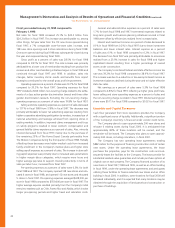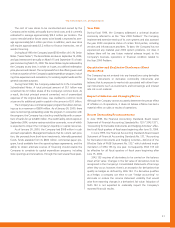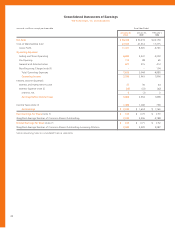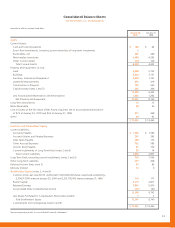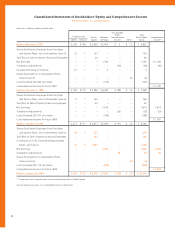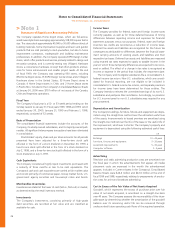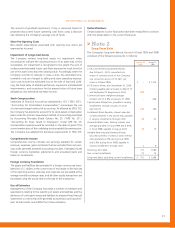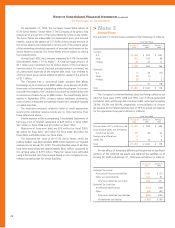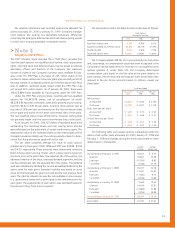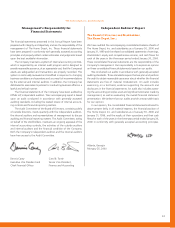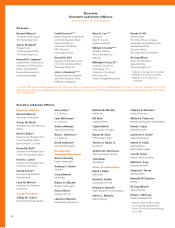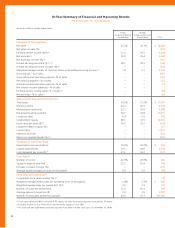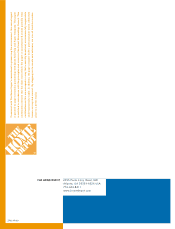Home Depot 1999 Annual Report Download - page 34
Download and view the complete annual report
Please find page 34 of the 1999 Home Depot annual report below. You can navigate through the pages in the report by either clicking on the pages listed below, or by using the keyword search tool below to find specific information within the annual report.
Notes to Consolidated Financial Statements (continued)
The Home Depot, Inc. and Subsidiaries
The following table summarizes information regarding stock options
outstanding as of January 30, 2000 (option shares in thousands):
Weighted Weighted Weighted
Number of Average Average Average
Range of Options Remaining Outstanding Options Exercisable
Exercise Prices Outstanding Life (Years) Option Price Exercisable Option Price
$ 4.00 to 8.00 2,670 2.0 $ 6.90 2,670 $ 6.90
8.00 to 15.00 32,289 6.2 10.20 17,143 9.60
15.00 to 25.00 19,142 8.0 20.80 2,426 20.90
25.00 to 40.00 13,802 9.0 37.30 91 30.10
40.00 to 60.00 516 9.7 51.20 – –
68,419 7.1 $18.79 22,330 $10.61
In addition, the Company had 6,252,804 shares available for future
grants under the Employee Stock Purchase Plan (“ESPP”) at January 30,
2000. The ESPP enables the Company to grant substantially all
full-time associates options to purchase up to 99,618,750 shares
of common stock, of which 93,365,946 shares have been exercised
from inception of the plan, at a price equal to the lower of 85% of
the stock’s fair market value on the first day or the last day of the
purchase period. Shares purchased may not exceed the lesser of 20%
of the associate’s annual compensation, as defined, or $25,000 of
common stock at its fair market value (determined at the time such
option is granted) for any one calendar year. Associates pay for the
shares ratably over a period of one year (the purchase period) through
payroll deductions, and cannot exercise their option to purchase any
of the shares until the conclusion of the purchase period. In the event
an associate elects not to exercise such options, the full amount with-
held is refundable. During fiscal 1999, options for 5,691,474 shares
were exercised at an average price of $21.91 per share. At January 30,
2000, there were 2,860,618 options outstanding, net of cancellations,
at an average price of $37.64 per share.
>Note 5
Leases
The Company leases certain retail locations, office space, warehouse
and distribution space, equipment and vehicles. While the majority of
the leases are operating leases, certain retail locations are leased under
capital leases. As leases expire, it can be expected that in the normal
course of business, leases will be renewed or replaced.
In June 1996, the Company entered into a $300 million operating
lease agreement for the primary purpose of financing construction
costs for selected new stores. The Company increased its available
funding under the operating lease agreement to $600 million in May
1997. In October 1998, through a second operating lease agreement,
the Company further increased the available funding by $282 million
to $882 million. Under the agreements, the lessor purchases the prop-
erties, pays for the construction costs and subsequently leases the
facilities to the Company. The initial lease term for the $600 million
agreement is five years with five 2-year renewal options. The lease
term for the $282 million agreement is 10 years with no renewal
options. Both lease agreements provide for substantial residual value
guarantees and include purchase options at original cost on each
property. The Company financed a portion of its new stores in fiscal
1997, 1998 and 1999, as well as an office building in fiscal 1999, under
the operating lease agreements. The Company anticipates utilizing
these facilities to finance selected new stores and an additional office
building in fiscal 2000.
During 1995, the Company entered into two operating lease
arrangements under which the Company leases an import distribution
facility, including its related equipment, and an office building for store
support functions. The operating lease agreement for the office build-
ing terminated in 1999 when the Company refinanced the property
under the $600 million operating lease agreement. The initial lease
term for the import distribution facility is five years with five 5-year
renewal options. The lease agreement provides for substantial resid-
ual value guarantees and includes purchase options at the higher of
the cost or fair market value of the assets.
The maximum amount of the residual value guarantees relative to
the assets under the lease agreements described above is projected
to be $799 million. As the leased assets are placed into service, the
Company estimates its liability under the residual value guarantees
and records additional rent expense on a straight-line basis over the
remaining lease terms.
Total rent expense, net of minor sublease income for the fiscal
years ended January 30, 2000, January 31, 1999 and February 1, 1998
was $389 million, $321 million and $262 million, respectively. Real
estate taxes, insurance, maintenance and operating expenses appli-
cable to the leased property are obligations of the Company under the
building leases. Certain of the store leases provide for contingent
rentals based on percentages of sales in excess of specified mini-
mums. Contingent rentals for the fiscal years ended January 30, 2000,
January 31, 1999 and February 1, 1998 were approximately $11 million,
$11 million and $10 million, respectively.
30


